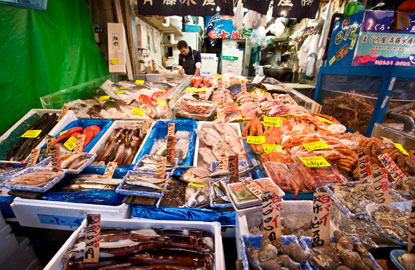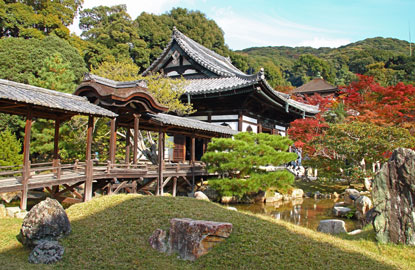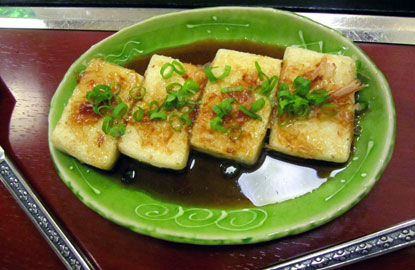By Lee Middleton
Be it samurai or manga, Hello Kitty or geisha, or maybe just the perfect piece of toro, cultural emissaries from the land of the rising sun continue to capture the global imagination. With typhoon season and sauna-like conditions finally ready to give way to autumn’s crisp climes and displays of pigmentary prowess, now is the time to check impressions at the door and enter the sublime reality that is Japan. The best way to explore this unique land? A trip by train from Tokyo to Kyoto with a detour along the Izu Peninsula provides the perfect blend of awe-inspiring Asian megalopolis, tranquil hot springs retreat, and real-life Memoirs of A Geisha moments.

Tokyo: the Big Tuna
Glitzy Ginza, manga cafes, the Shibuya Crossing crowds, vending machines to suit, er, all tastes: whatever your association, this legendary metropolis can’t be missed. Whatever you do get up to, don’t skip the Tsukiji Fish Market. The world’s largest fish and seafood market, this downtown Tokyo institution sees millions of dollars in sea creatures traded every day. After you’ve had your fill of the 5 am fishy frenzy (the timing makes it a great excursion for the jet-lagged), head to the market’s sushi joints, where you can say ohayou gozaimasu to the rising sun over the sweetest raw fish breakfast you never imagined possible.

Stop to Smell the…Donuts
Winding your way through the underground warren of shopping opportunities that encircle Tokyo Station, if you happen to see a "Mochi Cream" franchise (site in Japanese), do yourself a favor and stop. When in Japan, it is vital to indulge that instinct to pause for seemingly unnecessary but intriguing (and possibly weird) treats. The occasional squid popsicle will be more than compensated for by delights like mochi donuts. Temperature is the first surprise. A cold donut? Then it clicks: this is a donut-shaped ring of ice cream surrounded by mochi (that Japanese confection of sticky rice flour) encased in a shell of variously flavored sugary glaze (walnut, mango, pistachio, etc.). Wonderful, whimsical, and way too small if you only order one.
Recommended Fodor’s Video

Izu Hot Spring Perfection
Any Shogun fans out there? Just an hour-ish from Tokyo by train, the rocky coastline of the Izu Peninsula inspired the setting for Captain Blackthorne’s shipwreck and subsequent shenanigans. Izu’s real draw, however, is its abundance of natural hot springs (onsen to the Japanese) and the charming inns that cater to the bathers. Standing out amongst them is the stupendous Arcana Izu Resort. Overlooking the Kano River’s limpid pools and surrounded by lush forest (riot of changing colors anyone?), Arcana’s luxurious rooms (a showcase of modern Japanese architecture) all boast verandas with their own private spring baths amid the foliage. Perfection.
Once you’ve soaked your heart out, heed the Japanese tradition of following your bath with a meal. Dinner at Arcana’s Lumière restaurant will introduce you to a truly mind boggling culinary experience that melds French technique with Japanese produce in the most unexpectedly beautiful of unions. Do not miss this.

Zen and the Art of Everything
The imperial capital until 1868, Kyoto embodies all things old-school Japan: temples, gardens, geishas, craftsmanship, and harmony. All of these can be found in abundance (well, maybe not an abundance of geishas) at Kodai-ji temple. Of Kyoto’s hundreds of temples, this Zen edifice and its surrounding gardens are a particularly spectacular place from which to enjoy the fall colors. The surrounding neighborhood includes the amazingly picturesque historic zone around Ninenzaka and Sannenzaka: be sure to leave time to get lost amid the traditional machiya (wooden houses), many of which now serve as elegant teahouses or quaint shops selling handcrafted items.

For the Love of Soy
Like many things, tofu originated in China but was perfected in Japan. And as with most things Japanese, mastery of the craft is considered highly regional, with Kyoto deemed the place in the country to eat quality tofu. Need we say more? Come experience soy’s platonic ideal, as realized at Sosoan, one of a handful of Kyoto’s excellent tofu restaurants. Serving fresh tofu (those who have never enjoyed this delicacy will be awed into submission) in a shocking variety of forms—creamy as pudding, light and airy, dense and chewy—Sosoan’s multi-course "kaiseki" meal must be pre-booked and will only set you back 3800 yen (about $50) at lunch. Located just a block from the charming and well-trod Philosopher’s Path, this tranquil neighborhood restaurant also sells fresh tofu and soymilk like you’ve never known them.
Travel Tips
Take the Train
If you’re in-country for at least a week and plan to do the Tokyo-Kyoto roundtrip, purchase a JR Rail Pass. Providing unlimited train travel on the national JR line for a prescribed length of time (and valid on JR’s highly useful Tokyo lines and some buses), the pass will save you a pile of yen. Don’t be put off by the somewhat confusing website explanations about types of trains and routes. The takeaway message: it’s only available for sale outside Japan (yes, that means buy it before you leave), the ordinary pass will do just fine (vs. green), and if you plan to hit more than one long distance destination, you won’t regret it.
When at the larger stations, look for the "green window" (midori-no-madoguchi), which should be staffed by someone who speaks English. To find train schedules in English, check out Hyperdia.com. Some additional useful explanations on using the pass can be found at Japan-Guide.com.
Where to Stay
Representing numerous properties from simple guesthouses to exquisite boutique inns all over the country, Japanese Guesthouses offers access to great properties not usually available to a non-Japanese speaking client. The Ryokan Collection provides a similar service, but for a more exclusive portfolio of dream locations, including Arcana Izu Resort.
Where to Eat
Japan is one of those rare places where it’s actually difficult to have a bad meal. However, it can also be difficult to find English menus or to know exactly what kind of restaurant you’ve entered (Japanese restaurants tend to specialize, so you won’t find sushi at a yakitori place). Trust your concierge and local advice, but if you want to forge out on your own, these blogs contain some invaluable restaurant and food tips: JustHungry.com JapaneseFoodReport.com and KyotoFoodie.com (don’t worry about dated restaurant postings, things don’t change so quickly in Japan).
What about a road trip of a lifetime? Check out our itinerary for an awe-inspiring drive through South Africa’s garden route.
Photo Credits: Tokyo: (c) Sbures | Dreamstime.com; Donuts: 2012 Bangkok Thailand Trip 1 Day 5 by
Attribution-NonCommercial-ShareAlike License; Izu hot spring: © arcana; Zen: Kodai-ji temple via Shutterstock.com; Love of the bean: href=”http://www.flickr.com/photos/donutgirl/6030462639/”>tofu by Amy Ross
Attribution-ShareAlike License


